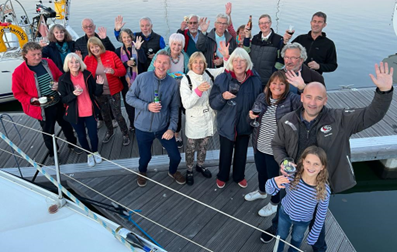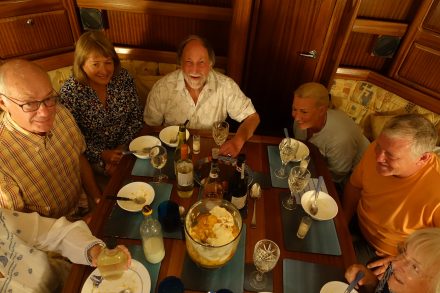- This topic is empty.
-
AuthorPosts
-
December 23, 2010 at 7:07 pm #6506
Anonymous
Just been down to check my yacht which is afloat in a marina. I have only just bought this Bavaria 30 2006 model. It has been prepared for the winter by the previous owner and I have set up a 3 foot tube heater which is constantly on. I checked the engine’s fresh and sea water and neither were frozen. I then touch-checked the calorifier and curiously found it warm, not hot, just warm. I have shore power plugged in for the tube heater but both 12v master switches are off, the engine hasn’t been run so where is it getting the heat source from, any ideas ?
Cheers
cdoggDecember 23, 2010 at 9:15 pm #8473Anonymous
Calorifiers are never (AFAIK) heated from the 12V batteries but they are frequently fitted with mains powered immersion heaters. The most likely scenario is that the calorifier has such an immersion heater and this is connected when on shore power.
I am, however, surprised that the calorifier is not hot to the touch. The immersion heater would normally have a thermostat (like the one in your hot water cylinder at home) that would keep the water heated to 60C or so, i.e. hot. I assume the calorifier is full of water, otherwise there is a strong likelihood that the immersion heater element will burn out!
It is worth checking to see if this is the case. There is normally an on/off switch for the calorifier.
When on shore power for a long period (i.e. during the winter), I run the shorepower cable straight into the cabin and plug the heater/dehumidifier into that, bypassing the boat shorepower connector. This means the boat remains isolated from the mains and any stray current/galvanic action problems etc. are completely avoided.
Good hunting.
Roger
December 24, 2010 at 9:55 am #8474Anonymous
Thanks Roger,
I eventually managed to speak to the previous owner and for the last three freezing winters (Scotland) he never switched off the Calorifier and it didn’t seem to harm it. Given that it has been left ‘on’ for the past few weeks I have been advised to leave it alone until the first thaw (probably about May!), then put some water in the water tank and test run the system. If all is ok, then make the decision what to do for the rest of the winter. The view is that if I simply switch it off now, any water in the calorifier may freeze. As you’d guess, the instruction manuals don’t refer to this situation or if they do, it is in German! I like your suggestion of taking the mains supply directly from the power lead socket, although this would leave the battery charger/conditioner without power.
Merry Christmas to you
cdoggDecember 24, 2010 at 10:24 am #8475Anonymous
Glad to hear the problem has been solved, although I’m still surprised it was not hot to the touch. If the calorifier is full of water then it should get hot. If it’s empty then there is a strong possibility that the element will burn out. Maybe it’s half full! 🙂
At least the main mystery is solved and you can relax over Christmas!
Have a good one.
Roger
December 24, 2010 at 5:37 pm #8476Anonymous
This has got me thinking now about the posssibility of stray current causing corrosion. My boat stays on the water for use during the winter and I leave the shore power on to top up the batteries and power the heater and dehumidifier. Done this for a few years now without any problems.
What do you think the likelihood is of any such corrosion problems in a 5 year old Bavaria?
Has anyone had any such issues do we know?
I’ll probably eat my Christmas dinner envisaging the underwater metal bits dissolving into the marina!!
Cheers
DerekDecember 24, 2010 at 7:19 pm #8477Anonymous
Nice to know I am not the only one with an over active imagination Derek. I did smile at your comment, as many years ago we had a VERY old farmhouse needing lots of restoration – so much so that a good friend, a building surveyor by profession, could not relax when visiting us as he was convinced he could hear the woodworm chomping away and the rising damp and dry rot busy demolishing the house. Funny old thing, imagination!
What I have discovered about forums, in my limited use, is that once you get good advice that comforts you, someone else comes up with equally plausible other advice about potentially nasty consequences of that action. Don’t get me wrong, I am indebted to those wiser and more experience than I, who help me decide on a course of action I can live with.
Merry Christmas
CdoggDecember 24, 2010 at 8:14 pm #8478Anonymous
Thanks, feel much better now, I can worry about the snow piling up against the wall over the top of the damp course, which will in time, cause wet rot and soften the mortar causing the house to fall down. Have to live on the boat then as long as the galvanic action hasn’t taken out the sea cocks and sent the whole boat into a watery grave!
Good job I’m an optimist, ho ho ho,, merry christmas. Back to the vino.
Derek
December 24, 2010 at 10:17 pm #8479Anonymous
@Jalani wrote:
What do you think the likelihood is of any such corrosion problems in a 5 year old Bavaria?
Hi Derek
There is no simple answer; it depends on a number of factors, some of which are complex and not fully understood (by me at least) – hence my cautious approach to prolonged AC connection.
Firstly, it depends whether the AC earth and DC ground (negative or (loosely) DC earth) are connected together on your boat (either directly or through something like the battery charger). It used to be Bavaria policy not to connect these together. However, it is mandatory in the US and is now advised in the EU (see ISO 13297 – Small craft — Electrical systems — Alternating current installations) although it is not mandatory (in the EU) if an RCD is fitted.
If the earths are connected together it then depends if the DC earth is connected to any underwater metals parts on your boat (like seacocks, anodes, saildrive leg etc.), and also whether a galvanic isolator is fitted in the AC earth line.
I could go on but it would probably get (even more?) boring.
In short, as far as I know, Bavarias do not have any such problems because the AC and DC earths are kept separate.
I suggest you forget about it, relax and enjoy your dinner tomorrow. Life’s too short . . . . !
Have a good one.
Roger
December 31, 2010 at 2:08 pm #8480Anonymous
Follow up on my calorifier puzzle.
Just back from the boat, stayed overnight. As most of you suggested, the calorifier is indeed fitted with a mains element which I have now found is switchable from the main switch panel (labelled in German). As I may have said earlier, the previous owner prepared the boat for this winter exactly as he had done in previous years and that included leaving the calorifier ‘on’ (when connected to shore power) with sufficient water in the tank to avoid damage through the unit overheating etc. The plus side is that it is keeping the rest of the ‘water-works’, which are all within that general area, above freezing. The heat also permeates through to the engine. The down side is it is consuming electricity. I have now felt the temperature of the calorifier at a part of the tank where it is not heavily insulated and it is in fact hot, not just warm as I reported earlier. I have therefore decided to leave it as it is for the rest of this winter and review what I do for next winter when the time comes. As always, the wiser among you will no doubt point out some of the down sides of my action, but it seems to have worked out so far.
Thank you for your comments and advice
cdoggDecember 31, 2010 at 3:41 pm #8481Anonymous
Interested to read your last post because I if I have wanted to switch off the mains supply to the calorifier I have been lifting the aft cabin bunk boards and unplugging the supply which is a bit awkwardand inconvenient to do.
You say that on your Bavaria there is a switch on the main panel which turns off the supply. I can’t find it on mine, am I missing something glaringly obvious?
Cheers
DerekDecember 31, 2010 at 5:01 pm #8482Anonymous
Derek
It’s usually a large orange neon switch (should light up when there is power to the calorifier) on the right hand side of the panel just below the battery/tank gauges.
Or at least thats where it is on my 36.
Cheers
RickDecember 31, 2010 at 7:10 pm #8483Anonymous
Rick
Thanks for that, I haven’t got one of those, serves me right for being tight and only buying a Bav 30!
Cheers
DerekDecember 31, 2010 at 9:14 pm #8484Anonymous
Rick,
My electrical panel is split into two side by side panels, at the bottom of the right hand panel there are four larger switches, one of these switches has a heater coil symbol which switches off the calorifier another has a shower symbol, the third has a capital K with a circle around it (not sure what this one is, maybe battery charger) and the fourth is the master for all of the shore power connections.
I haven’t had time to suss it all out yet.
cdoggJanuary 2, 2011 at 1:11 pm #8486Anonymous
This may be of use to you in sorting out what does what. If you go to this web page you can download the instructions for panels 301 and 302.
Any use?
SerendipityJanuary 2, 2011 at 7:39 pm #8488Anonymous
Thanks Serendipity.
I have downloaded the pages and find the right hand panel is the same as my one and answers my questions – in English! The left hand panel is not the same as my one but the symbols descriptions plus trial and error will provide the solution. I will then re-label the breakers.
Strangely, my earlier Google searches didn’t find your pages.
Thanks again
cdogg -
AuthorPosts
- You must be logged in to reply to this topic.




